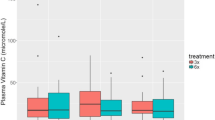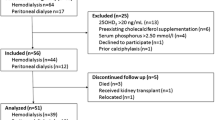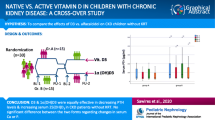Abstract
Introduction
Adherence to therapy is a relevant challenge in chronic hemodialysis patients. The directly observed therapy (DOT) could be an effective method to increase adherence for specific therapies. We aimed to study the performance of DOT versus home medication. We follow the impact of providing native vitamin D directly by the nurse after a dialysis session on the 25-hydroxyvitamin [25(OH)D] concentrations.
Methods
In this observational study, we included 38 dialysis patients treated by stable dosage of cholecalciferol. DOT was implemented in December 2010. We considered the concentrations of 25-OH vitamin D three times before (T1 = June 2010, T2 = July 2010 and T3 = September 2010) and three times after the modification of prescription (T4 = February 2011, T5 = March 2011 and T6 = April 2011).
Results
Median age was 72 [62; 79] years and 48 % were diabetics. Mean body mass index was 26 ± 5 kg/m2 and median dialysis vintage was 20 [8; 46] months. The patients were compared to themselves. Before DOT, median concentrations of 25(OH)D were 27 (14–36), 23 (17–31), 31 (22–38) ng/mL at T1, T2 and T3, respectively. When DOT was effective, the concentrations significantly increased to 34 (28–44), 35 (29–41), 39 (32–47) ng/mL at T4, T5 and T6, respectively. Before DOT, 19 patients (50 %) reached the target of 30 ng/mL. After DOT, 29 patients (76 %) reached the target concentration of 30 ng/mL.
Conclusions
In hemodialysis patients, DOT is both simple and effective to increase the therapeutic impact to native vitamin D.


Similar content being viewed by others
References
Burnier M, Pruijm M, Wuerzner G, Santschi V (2015) Drug adherence in chronic kidney diseases and dialysis. Nephrol Dial Transplant 30(1):39–44
Neri L, Martini A, Andreucci VE, Gallieni M, Rey LA, Brancaccio D (2011) Regimen complexity and prescription adherence in dialysis patients. Am J Nephrol 34(1):71–76
Schmid H, Hartmann B, Schiffl H (2009) Adherence to prescribed oral medication in adult patients undergoing chronic hemodialysis: a critical review of the literature. Eur J Med Res 14(5):185–190
Karamanidou C, Clatworthy J, Weinman J, Horne R (2008) A systematic review of the prevalence and determinants of nonadherence to phosphate binding medication in patients with end-stage renal disease. BMC Nephrol 9:2
Volmink J, Garner P (2007) Directly observed therapy for treating tuberculosis. Cochrane Database Syst Rev (4):CD003343
(2009) KDIGO clinical practice guideline for the diagnosis, evaluation, prevention, and treatment of chronic kidney disease-mineral and bone disorder (CKD-MBD). Kidney Int Suppl (113):S1–S130
Cavalier E, Delanaye P, Moranne O (2013) Variability of new bone mineral metabolism markers in patients treated with maintenance hemodialysis: implications for clinical decision making. Am J Kidney Dis 61(5):847–848
Delanaye P, Weekers L, Warling X et al (2013) Cholecalciferol in haemodialysis patients: a randomized, double-blind, proof-of-concept and safety study. Nephrol Dial Transplant 28(7):1779–1786
Cavalier E, Delanaye P, Chapelle JP, Souberbielle JC (2009) Vitamin D: current status and perspectives. Clin Chem Lab Med 47(2):120–127
Wolf M, Shah A, Gutierrez O et al (2007) Vitamin D levels and early mortality among incident hemodialysis patients. Kidney Int 72(8):1004–1013
Foley RN, Parfrey PS, Sarnak MJ (1998) Clinical epidemiology of cardiovascular disease in chronic renal disease. Am J Kidney Dis 32(5 Suppl 3):S112–S119
Kangovi S, Mukherjee J, Bohmer R, Fitzmaurice G (2009) A classification and meta-analysis of community-based directly observed therapy programs for tuberculosis treatment in developing countries. J Community Health 34(6):506–513
Hill AR, Manikal VM, Riska PF (2002) Effectiveness of directly observed therapy (DOT) for tuberculosis: a review of multinational experience reported in 1990–2000. Medicine (Baltimore) 81(3):179–193
Hart JE, Jeon CY, Ivers LC et al (2010) Effect of directly observed therapy for highly active antiretroviral therapy on virologic, immunologic, and adherence outcomes: a meta-analysis and systematic review. J Acquir Immune Defic Syndr 54(2):167–179
Bhan I, Camargo CA Jr, Wenger J et al (2011) Circulating levels of 25-hydroxyvitamin D and human cathelicidin in healthy adults. J Allergy Clin Immunol 127(5):1302–1304
Jean G, Lataillade D, Genet L et al (2011) Impact of hypovitaminosis D and alfacalcidol therapy on survival of hemodialysis patients: results from the French ARNOS study. Nephron Clin Pract 118(2):c204–c210
Armas LA, Andukuri R, Barger-Lux J, Heaney RP, Lund R (2012) 25-Hydroxyvitamin D response to cholecalciferol supplementation in hemodialysis. Clin J Am Soc Nephrol 7(9):1428–1434
Massart A, Debelle FD, Racape J et al (2014) Biochemical parameters after cholecalciferol repletion in hemodialysis: results from the VitaDial randomized trial. Am J Kidney Dis 64(5):696–705
Wasse H, Huang R, Long Q, Singapuri S, Raggi P, Tangpricha V (2012) Efficacy and safety of a short course of very-high-dose cholecalciferol in hemodialysis. Am J Clin Nutr 95(2):522–528
Jean G, Souberbielle JC, Chazot C (2009) Monthly cholecalciferol administration in haemodialysis patients: a simple and efficient strategy for vitamin D supplementation. Nephrol Dial Transplant 24(12):3799–3805
Conflict of interest
We have no conflict of interest to declare.
Ethical approval
This study was performed in accordance with the institutional research and Helsinki declaration. Notably, all data were treated confidentially and anonymously.
Informed consent
All patients signed informed consent.
Author information
Authors and Affiliations
Corresponding author
Rights and permissions
About this article
Cite this article
Delanaye, P., Cavalier, E., Fafin, C. et al. Efficiency of delivery observed treatment in hemodialysis patients: the example of the native vitamin D therapy. J Nephrol 29, 99–103 (2016). https://doi.org/10.1007/s40620-015-0196-y
Received:
Accepted:
Published:
Issue Date:
DOI: https://doi.org/10.1007/s40620-015-0196-y




